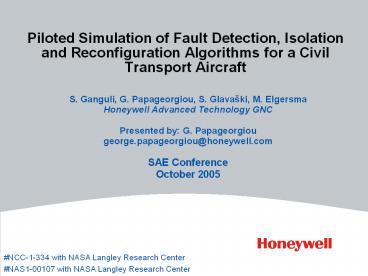Piloted Simulation of Fault Detection, Isolation and Reconfiguration Algorithms for a Civil Transport Aircraft - PowerPoint PPT Presentation
Title:
Piloted Simulation of Fault Detection, Isolation and Reconfiguration Algorithms for a Civil Transport Aircraft
Description:
Aircraft Control Surfaces Commanded Control ... Piloted Simulation Verification of a Control Reconfiguration for a Fighter Aircraft under Impairment , AGARD ... – PowerPoint PPT presentation
Number of Views:198
Avg rating:3.0/5.0
Title: Piloted Simulation of Fault Detection, Isolation and Reconfiguration Algorithms for a Civil Transport Aircraft
1
Piloted Simulation of Fault Detection, Isolation
and Reconfiguration Algorithms for a Civil
Transport Aircraft
- S. Ganguli, G. Papageorgiou, S. Glavaški, M.
Elgersma - Honeywell Advanced Technology GNC
- Presented by G. Papageorgiou
- george.papageorgiou_at_honeywell.com
- SAE Conference
- October 2005
NCC-1-334 with NASA Langley Research
Center NAS1-00107 with NASA Langley Research
Center
2
Aircraft Control Surfaces
- Commanded Control Surfaces (via autopilot)
- Aileron Difference
- Average Elevator
- Rudder
3
Piloted Simulation Setup
4
IFD vs Matlab Comparative plots
5
CUPRSys Overview
6
CUPRSys Algorithms Aircraft Model
- Express aircraft dynamics as sum of nominal
nonlinear function and a linear combination of
(nonlinear) basis functions.
- Aircraft equations
7
Flight Conditions
Reduction of effectiveness faults and various
maneuvers
8
Matlab Simulation (Low Cruise Pitch Down)
Pilot modeled by Prop. Gain
- No Fault -. 75 Fault .. Reconfigured - Command
9
Flight Card
10
Low Cruise 10 deg Pitch Down (No fault)
11
Low Cruise 10 deg Pitch Down (75 ?e fault)
12
Low Cruise 10 deg Pitch Down (Reconfiguration)
Larger command
13
Low Cruise 10 deg Pitch Down (Reconfiguration)
Smaller command
14
Cooper Harper Ratings Pilot Workload - LC
(5 rad/s)
(2 rad/s)
LP
2
HP
Low Cruise
R. Mercadante, Piloted Simulation Verification
of a Control Reconfiguration for a Fighter
Aircraft under Impairment, AGARD No. 456,
Toulouse, France, 1989
15
FDI Performance
- Performance measured by
- False-alarms
- 1 LC pitch-up maneuver, and during flare tasks
(ground effects not modeled?) - Missed detection (none, but sensitivity to small
faults not tested) - Accuracy of identified fault
16
Lessons Learnt and Recommendations
- Limitations
- CUPRSys uses ? and ? sensors typically not
available - Feel system model not available for design
- Current deficiencies of CUPRSys
- On-board aircraft model uses exact replica of
Engine Model - H-matrix and Threshold Functions vary with flight
condition - Gain reconfiguration vs control re-allocation
- CUPRSys restricted to gain reconfiguration
(commanding through autopilot) - Control authority of additional surfaces can
restore flying qualities
17
Conclusions Future Work
- Piloted simulations conducted at LaRC suggest
- Robust control law
- Promising FDIR capabilities (need more validation
sims with control re-allocation) - Future Work
- Utilize control allocation
- Accommodate sensor dynamics and noise
- Accommodate turbulence
- Expanded set of failures
18
Pilot Cueing
19
Integration Flight Deck (IFD)
- Piloted Simulations were conducted at the LaRC
IFD facility.
20
Acknowledgement
- Thanks to the NASA Team for their support,
encouragement and various helpful discussions - Pat Murphy
- Steve Derry
- Gus Taylor
- Rob Rivers
- Tom Bundick
- Christine Belcastro
21
www.honeywell.com
22
NASA Aviation Safety Security Program
- NASA AvSSP
- 500 million
- Reduce commercial aviation accident rate by 80
by 2007
( http//www.nasa.gov/centers/langley/news/factsh
eets/AvSP-factsheet.html)
http//avsp.larc.nasa.gov/program.html
23
AMASF Program Overview
- Phase I (mid-sized commuter aircraft)
- FDI technologies for selected failures
(stuck/floating actuators, reduction of control
surface effectiveness) icing - Pilot Cueing strategies
- Control Reconfiguration
- Phase II (mid-sized civil transport aircraft)
- Transition of algorithms to new aircraft
- Algorithms display integrated to CUPRSys
- Failure type reduction of control surface
effectiveness - Phase III
- Piloted simulation at LaRC
24
CUPRSys Algorithms Reconfigurable CLAW
- Based on Dynamic Inversion
- Desired Dynamics
- Control Law (under certain assumptions)
feedforward
DI
P I
K?
25
CUPRSys Algorithms Reconfigurable CLAW
- Controller bandwidths
- High dynamic pressure (High/Low Cruise)
- p C ? 2.0 1.25 1.0 rad/s
- Low dynamic pressure (near Approach)
- p C ? 2.5 0.75 0.75 rad/s
- Inceptor Scalings
- Wheel (?85 deg) 0.25 (deg/s)/deg
- Column (-9.2 to 13.3 deg) 2.00 (deg/s)/deg
- Pedal (?4 inch) 0.02 rad/inch
- Anti-windup (software limiting)
fc
Inversion
Kb
fiKb
1/s
Kaw
sat lim
26
CUPRSys Algorithms Fault Detection
- Residual Generator
Angular Acceleration Estimator
Scaled, Added
Noise Rejection
- Threshold Function
abs( )
LP
Scaled, Added
Bias
Turbulence Rejection
27
CUPRSys Algorithms Fault Isolation
- RLS Estimator
- After acquiring k samples
- Over-determined linear algebra problem
- Weighted Least Squares problem
- Solved using standard RLS Estimation algorithm
with forgetting factor.
28
CUPRSys Algorithms Fault Isolation
- H-Matrix Convergence Criterion
- H-Matrix Update
- H-matrix for FD (Residual Generator)
- H-matrix for CLAW
- Signal Injection
- Trade-off between sufficient excitation time and
quick FDIR - Simultaneous doublet commands (4 sec) in all
three axes - 0.5 deg/s p
- 0.5 deg/s C
- 1 deg ?
and
29
High Cruise 10 deg Pitch Down (No fault)
light turbulence
30
High Cruise 10 deg Pitch Down (75 ?e fault)
31
High Cruise 10 deg Pitch Down (Reconfiguration)
32
Cooper Harper Ratings Pilot Workload
LP
2
HP
High Cruise































